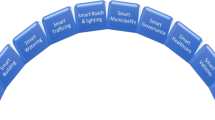Abstract
From a computational perspective, the Covid-19 pandemic experienced around the world shows different lessons for society. Among the lessons, collecting data efficiently and effectively in pervasive environments proved to be one of the greatest challenges. Citizens and government agencies need data that portray the reality of the situation experienced in different environments, such as university campuses, neighborhoods and cities. This article presents as a contribution a computational architecture for the development of applications for pervasive environments using IoT and based on simulation. This research was carried out based on design science research through our proposed architecture. Experimental results showed interesting scenarios that could be differentiated for government agencies, considering IoT sensors, during a pandemic such as Covid-19. This work presents a scenario based on the contamination of Covid-19 in a pervasive and intelligent environment. In addition, the architectural approach provides support to scenarios visualization, which allows interesting parameters to decisions.
Access this chapter
Tax calculation will be finalised at checkout
Purchases are for personal use only
Similar content being viewed by others
References
WHO, Coronavirus disease 2019 (COVID-19): situation report, 72. https://apps.who.int/iris/bitstream/handle/10665/331685/nCoVsitrep01Apr2020-eng.pdf. Accessed April 2020
IMF. https://www.imf.org/en/Topics/imf-and-covid19. Accessed April 2020
Oracle. https://www.oracle.com/big-data/what-is-big-data.html. Accessed April 2020
Burton-Jones, A., et al.: Changing the conversation on evaluating digital transformation in healthcare: Insights from an institutional analysis. Inf. Organ. 30(1), 100255 (2020)
Luo, C., et al.: Brush like a dentist: accurate monitoring of toothbrushing via wrist-worn gesture sensing. In: IEEE INFOCOM 2019-IEEE Conference on Computer Communications, pp. 1234–1242. IEEE (2019)
Tardieu, H., Daly, D., Esteban-Lauzán, J., Hall, J., Miller, G.: Case study 2: the digital transformation of health care. In: Deliberately Digital, pp. 237–244. Springer, Cham (2020)
Ricciardi, W., et al.: How to govern the digital transformation of health services. Eur. J. Public Health 29(Supplement_3), 7–12 (2019)
Nazário, D.C., et al.: Quality of context evaluating approach in AAL environment using IoT technology. In: 2017 IEEE 30th International Symposium on Computer-Based Medical Systems (CBMS), pp. 558–563. IEEE (2017)
da Silva, M.P., Gonçalves, A.L., Dantas, M.A.R.: A conceptual model for quality of experience management to provide context-aware eHealth services. Future Gener. Comput. Syst. 101, 1041–1061 (2019)
Cooking-hacks. e-health sensor platform v20 for arduino and raspberrypi. https://www.cookinghacks.com/documentation/tutorials/ehealthbiometricsensorplatformarduino-raspberry-pi-medical. Accessed April 2020
Skorin-Kapov, L., Matijasevic, M.: Analysis of QoS requirements for e-health services and mapping to evolved packet system QoS classes. Int. J. Telemed. Appl. 2010 (2010). https://doi.org/10.1155/2010/628086. Article ID 628086
Santana, E.F.Z., Chaves, A.P., Gerosa, M.A., Kon, F.: Software platforms for smart cities: Concepts, requirements, challenges, and a unified reference architecture. ACM Comput. Surv. (Csur) 50(6), 1–37 (2017)
Gomes, E., et al.: An ambient assisted living research approach targeting real-time challenges. In: IECON 2018–44th Annual Conference of the IEEE Industrial Electronics Society, pp. 3079–3083. IEEE (2018)
Simon, H.A.: The Sciences of the Artificial. MIT Press, Cambridge (2019)
Hevner, A.: A three cycle view of design science research. Scand. J. Inf. Syst. 19(2), 4 (2007)
PostgreSQL. https://www.postgresql.org/. Accessed May 2020
NEC SX-Aurora TSUBASA, NEC Vector Engine Models. https://www.nec.com/en/global/solutions/hpc/sx/vector_engine.html. Accessed May 2020
Siafu Simulator. https://siafusimulator.org/. Accessed May 2020
Walker, P.G.T., et al.: The global impact of COVID-19 and strategies for mitigation and suppression. Imperial College London, London (2020)
Acknowledgments
This study was financed in part by the Coordination of Improvement of Higher Education Personnel – Brazil (CAPES) – Finance Code 001, Brazilian National Research Council (CNPq), Petrobras-RED Project and FAPEMIG/Brazil. This work has been supported by UFJF’s High-Speed Integrated Research Network (RePesq). https://repesq.ufjf.br/.
Author information
Authors and Affiliations
Corresponding author
Editor information
Editors and Affiliations
Rights and permissions
Copyright information
© 2021 The Author(s), under exclusive license to Springer Nature Switzerland AG
About this paper
Cite this paper
do Nascimento, M.G., Braga, R.M.M., David, J.M.N., Dantas, M.A.R., Colugnati, F.A.B. (2021). Towards an IoT Architecture to Pervasive Environments Through Design Science. In: Barolli, L., Woungang, I., Enokido, T. (eds) Advanced Information Networking and Applications. AINA 2021. Lecture Notes in Networks and Systems, vol 226. Springer, Cham. https://doi.org/10.1007/978-3-030-75075-6_3
Download citation
DOI: https://doi.org/10.1007/978-3-030-75075-6_3
Published:
Publisher Name: Springer, Cham
Print ISBN: 978-3-030-75074-9
Online ISBN: 978-3-030-75075-6
eBook Packages: Intelligent Technologies and RoboticsIntelligent Technologies and Robotics (R0)




